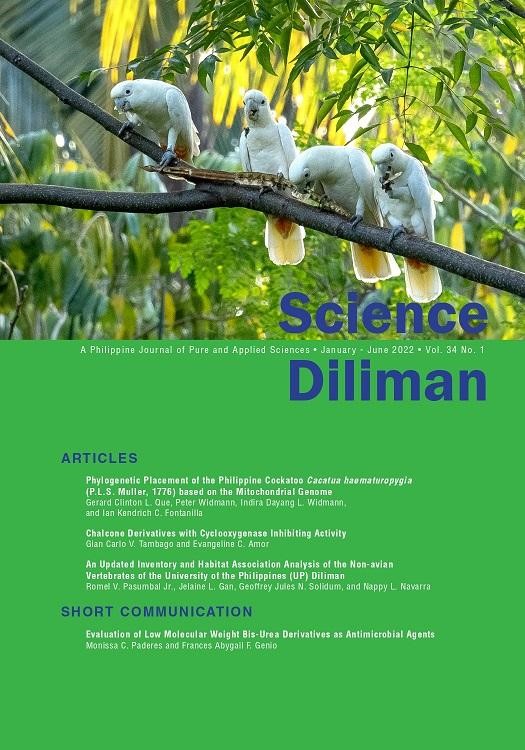Science Diliman Volume 34, No. 1 is now online.
The latest issue contains three articles and a short communication.

The articles are Phylogenetic Placement of the Philippine Cockatoo Cacatua haematuropygia (P.L.S. Muller 1776) based on the Mitochondrial Genome by Gerard Clinton L. Que, Peter Widmann, Indira Dayang L. Widmann, and Ian Kendrich C. Fontanilla; Chalcone Derivatives with Cyclooxygenase Inhibiting Activity by Gian Carlo V. Tambage and Evangeline C. Amor; and An Updated Inventory and Habitat Association Analysis of the Non-avian Vertebrates of the University of the Philippines (UP) Diliman by Romel V. Pasumbal Jr., Jelaine L. Gan, Geoffrey Jules N. Solidum, and Nappy L. Navarra.
The first article is a study analyzing the lines of descent and relationships of the Philippine parrot katala. Analysis showed that katalas are closely related to Tinambar corellas of Indonesia and the Western corellas of southwest Australia.
The second article is about the two chalcone (plant-derived compounds) extracted from the leaves of Syzygium samarangense or Java apple. The extracted compounds exhibited anti-inflammatory properties which may lead to the development of new anti-inflammatory drugs.
The last article presents the biodiversity survey conducted from August 2019 to February 2020 of the non-birds terrestrial vertebrates found in UP Diliman (UPD). The survey found that there were 33 non-avian vertebrate species, comprising seven amphibians, 15 reptiles, and 11 mammals spotted at UPD. The survey also revealed that a frog, two endemic snakes, skinks, and a gecko recorded in a 1998 survey were not spotted. Instead, new animals (two amphibians, seven reptiles, and six mammalian species) were sighted during the conduct of the survey. The study affirms the high species richness of UPD despite the numerous infrastructure projects on campus.
Meanwhile, the short communication Evaluation of Low Molecular Weight Bis-Urea Derivatives as Antimicrobial Agents is a study on 16 low molecular weight bis-urea derivatives that were screened for their in-vitro antimicrobial properties using the agar well diffusion method. This is among the continuing research that aims to discover new compounds with antimicrobial properties, especially since antibiotic resistance against common microbes is a worldwide concern.
The study was conducted by Frances Abygail F. Genio and Monissa C. Paredes.
Science Diliman is an internationally refereed, semi-annual journal of pure and applied science. It is listed in the ASEAN Citation Index and is a recipient of the journal incubation grant of the Commission on Higher Education Journal Incentive Program.
